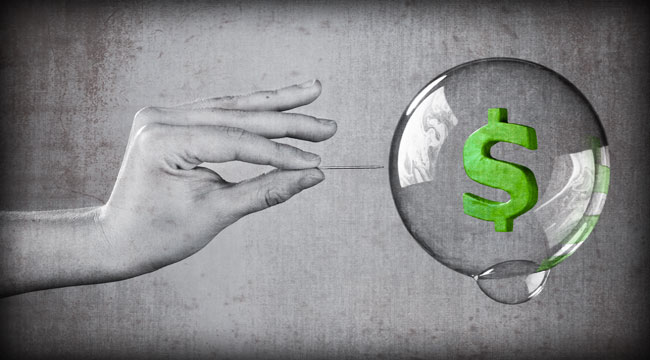Why Bubble Finance Will Fail
Dead wages and soaring financial assets has been going on for several decades now. Let the stock market’s rips serve as a portal into the ugly interior history of how central bank bubble finance has fostered an existential crisis in what remains of American capitalism.
On the main street side, this isn’t a matter of sluggish recovery from a mysterious financial crisis that arrived, apparently, on a comet from deep space in September 2008.
Alas, for three decades running now, the constant dollar weekly wages of full-time workers have been flat as a pancake. And let’s be clear. We are not talking about after school jobs held by quasi-perpetual students, the meager pay of moonlighting moms or the episodic work gigs of society’s tens of millions of loosely attached drifters.
To be sure, the ranks of these marginal job holders have become immense according to recent Social Security Administration data. It is “authoritative” compared to most of Washington’s statistical mill flotsam because it’s based on the payroll records of millions of employers who generally do not withhold taxes from ghosts.
To wit, there were about 50 million low wage job holders (under $15,000 per year) who as a group earned an average gross pay of just $6,000 in 2013.
Unless there is wholesale violation of the minimum wage laws, upwards of one-third of the US labor force of 155 million is working about 15 hours per week at the lowest lawful pay rate per hour. Call that a giant social problem.
In truth, however, it’s not the half of the real crisis. The latter is shown in the graph below, which is for “full-time” workers defined by the BLS as being on the job at least 35 hours per week.
Thirty years after it was ostensibly “Morning in America,” full-time wage workers have gained only 0.1% per annum in their weekly pay envelope.
That’s a rounding error — even if you believe that the BLS’ statistical shenanigans have actually captured cumulative inflation since 1986. In the real world, of course, actual inflation is much higher. That means real wages have self-evidently been sinking for 30 years.
Nor does this stagnant trend in real wage rates tell the entire story.

The share of the prime work age population holding any kind of job — even a few hours per week “coding” or delivering pizzas — is now down by fully 10 percentage points from the level it gained after women had fully entered the labor force in the 1990s.
Needless to say, even as the main street economy of work and production has been going nowhere, the financial system has erupted skyward.
During the last 35 years according to the Fed’s flow-of-funds calculations, the sum of credit market debt outstanding plus the market value of equities has soared from $6 trillion to $95 trillion or by fifteen times. By contrast, since 1981, nominal GDP has risen by only five times.
This is “financialization” in its full brobdingnagian glory.
The financial sphere was 212% of GDP in 1981. Today, it weighs in at 537%. See here:

Indeed, the S&P 500’s path could not happen in a free market. Even one with far more healthy fundamentals that the floundering recovery of the past six years.
In an honest free market gamblers would have to pay more for their carry funding. They’d face much greater uncertainty as to its price and availability and dissipate far more of their winnings hedging their portfolios than is required under the current central bank driven regime of bubble finance.
The contra-factual thus presents itself. Would the value of corporate equity have soared from $1.3 trillion to $36.5 trillion — or by 28 times — since 1981 in an honest free market?
Throw into the mix the Fed’s severe interest rate repression in the bond market and you get more financial inflation. When debt is priced drastically below its economic cost and receives a deep tax subsidy to boot, a variation of the supply side theorem manifests itself.
Namely, when the cost of servicing debt capital is made artificially low, you get a lot more of it — from the public and private sectors alike. The present day proclivity of politicians to kick-the-fiscal-can is a direct consequence of financial repression.
Also consider the explosion of corporate bond issuance, which in 1981 amounted to just $550 billion of outstandings or a mere 17% of GDP. Today that figure is $11.6 trillion or 20 times larger and amounts to 65% of GDP.
That explosion of new borrowings did not go into the acquisition of productive assets. If it had, real GDP would have grown a lot more rapidly than the 2.7% rate recorded for the 33 years ending in December 2014 and by the mere 1.1% recorded during the sub-period since Q4 2007.
Instead, the debt was overwhelmingly used for financial engineering. It is ultimately a Ponzi scheme by which new corporate borrowings are used to shrink the outstanding float of stock via leveraged buyouts, stock buybacks and cash merger and acquisition deals. Consequently, carry trade gamblers are enabled to bid up the shrunken supply equities to ever higher levels.
It’s no surprise that the US corporate sector’s market capitalization has exploded from $2 trillion in 1981 to $48 trillion at present.
That’s right. The nominal value of corporate debt at par plus equity at market has risen by 24 times. And most of that gain has occurred since the inauguration of monetary central planning under Greenspan in October 1987.
Bubble finance fosters dangerous instability. It is not by happenstance that the Greenspan Fed essentially threw in the towel when it authorized so-called “sweep accounts” on bank deposits in the early 1990s. That was a maneuver that essentially eliminated reserve requirements on traditional checking account money.
Not only does this mean that required reserves in the banking system now amount to a laughably microscopic 0.4% of deposits, but the whole apparatus is irrelevant anyway because banks are now only a minor source of new credit in the bubble finance system.
What central bank bubble finance has actually unleashed is a self-fueling form of asset-based credit creation.
The options, futures and currency markets, for example, are based on what amounts to loans which are collateralized by small fractions (1-10%) of the underlying current market value. As valuations rise ever higher, collateral values follow and implicit leverage grows. It is a financial beanstalk.
At the end of the day, the collateral based finance embedded in the current $95 trillion level of US credit and equity outstanding is far more dangerous than the old fashioned fractional reserve lending of the pre-1990 banking system.
At least under the old regime, bank regulators and central bankers like Paul Volcker were steeped in the tradition of safe and sound commercial banking.
By contrast, the post-Greenspan central bankers have opened a Pandora’s Box of market based hypothecated-finance. They do not have a clue about the enormous resulting bubble they have unleashed.
Nor do they understand that this $95 trillion monster is a voracious rent-seeking vampire squid that makes Goldman Sachs look little a piker. The relentless trading, churning and synthesizing of assets and derivatives within the giant bloated system of finance has almost nothing to do with raising or allocating capital for productive use.
Instead, this giant $95 trillion pool is where honest savings from the household and business sectors go to be scalped, appropriated and stolen by the hedge funds, dealers, financial engineers and gamblers which populate the casino. It is the excess girth of it that does the damage, magnifying the rent extraction and deadweight economic costs by orders of magnitude.
Stated differently, had the US economy not been “financialized” over the past 35 years and if the historic 200% ratio of credit market debt and corporate equity at market value still prevailed today, the size of the financial system would be $35 trillion, not $95 trillion.
On a playing field $60 trillion smaller would there not be far fewer fast money sharks churning, scalping and strip-mining the secondary markets in stocks, bonds, loans and their derivatives?
Maybe 100,000 people “live large” off today’s $95 trillion casino. By contrast, according to the Social Security Administration’s wage records, there were 100 million workers who held any kind of paying job during 2013, who earned a collective total of just $1.65 trillion that year.
That amounts to the incredibly small sum of just $16,500 per average worker. And not for a small slice of the labor force but fully two-thirds of all Americans with a job.
Full-time wage workers have been on a treadmill for decades. Average pay for the overwhelming share of jobs celebrated by the talking heads on payroll Friday is pitifully low. And the denizens of the Eccles Building keep their heavy foot on the monetary accelerator as they witlessly inflate a $95 trillion financial bubble. It’s a true financial vampire squid that they stubbornly deny even exists.
This is a clear and present danger to American capitalism fostered by an unelected monetary politburo in thrall to its own lust for power and mesmerized by its own doctrinaire group think.
The tragedy is that nothing can stop them except the thundering crash of the gargantuan bubble they have single handedly enabled…
Regards,
David Stockman
for The Daily Reckoning
P.S. Be sure to sign up for The Daily Reckoning — a free and entertaining look at the world of finance and politics from every possible angle. The articles you find here on our website are only a snippet of what you receive in The Daily Reckoning email edition. Click here now to sign up for FREE to see what you’re missing.



Comments: